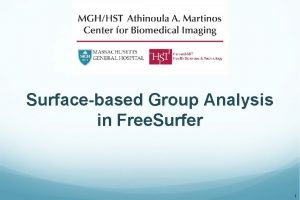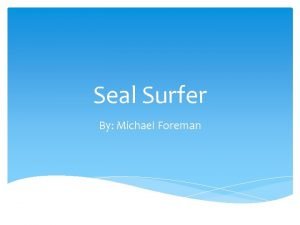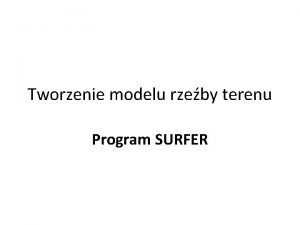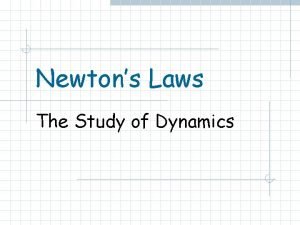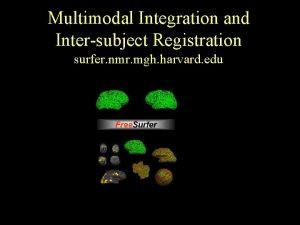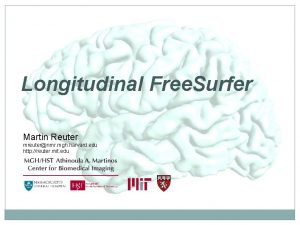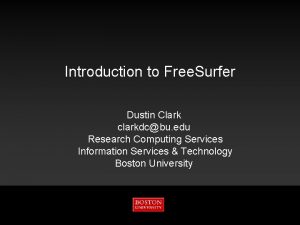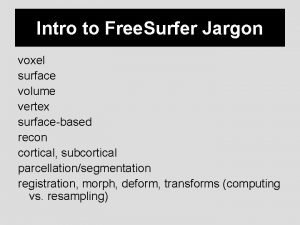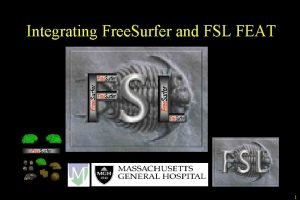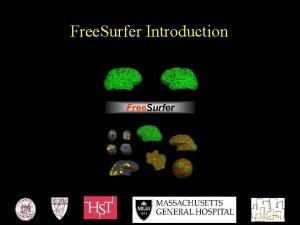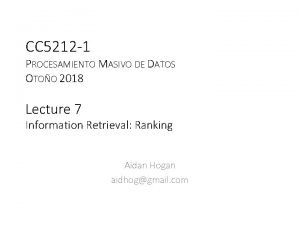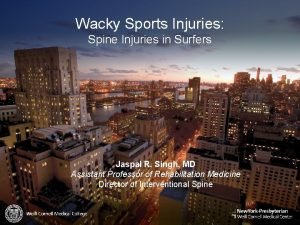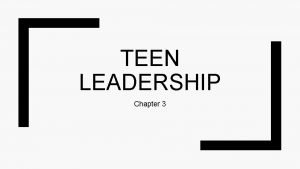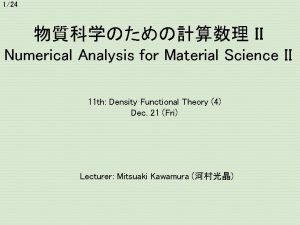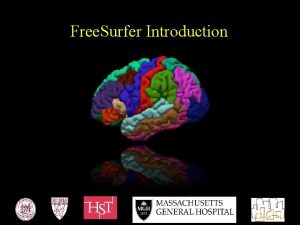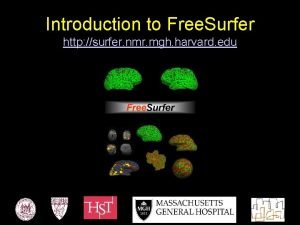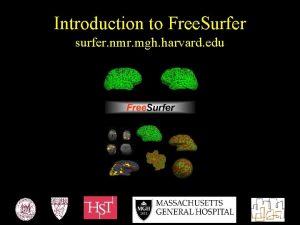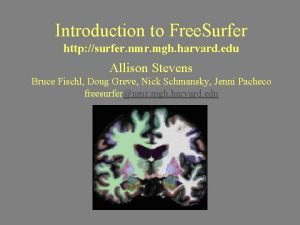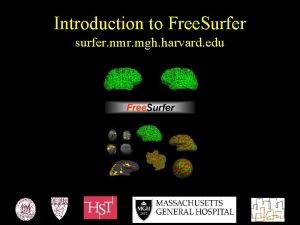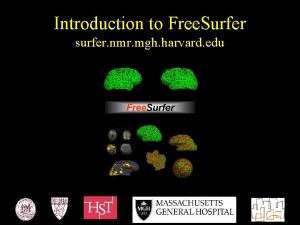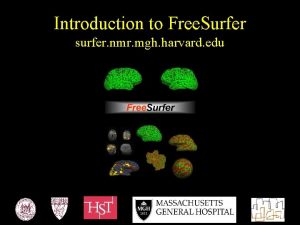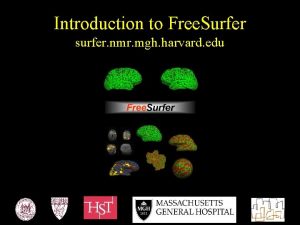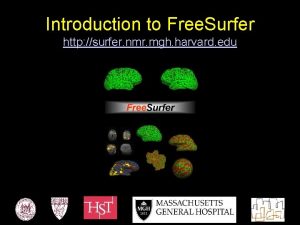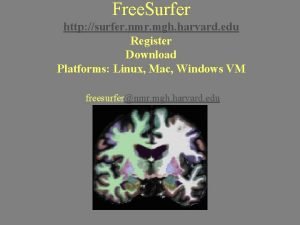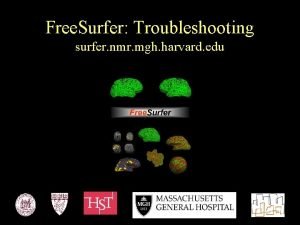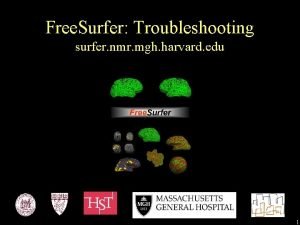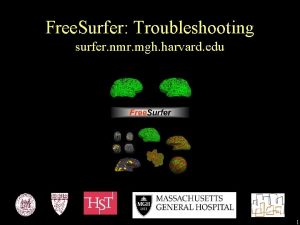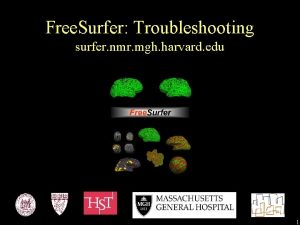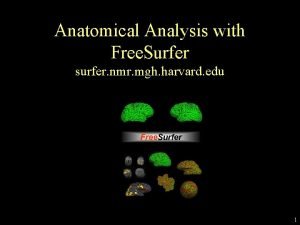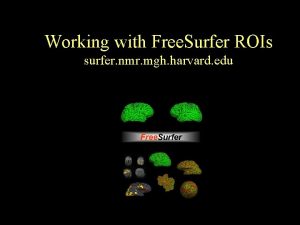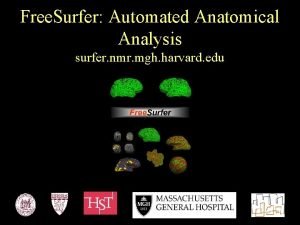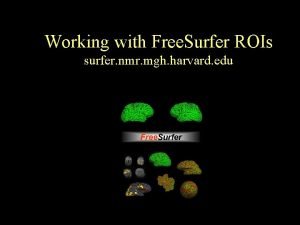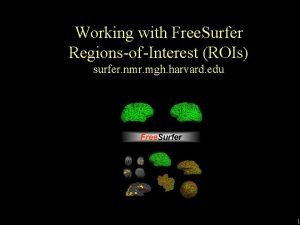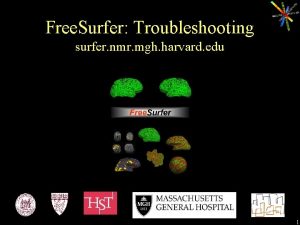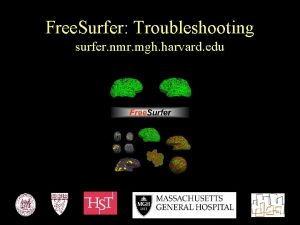Free Surfer Introduction The Free Surfer Team 2










































- Slides: 42

Free. Surfer Introduction

The Free. Surfer Team 2

The Free. Surfer Team Bruce Lilla Martin Longitudinal Doug Anastasia Registration Tractography f. MRI Software Engineers Nick Zeke Ruopeng Andre MR Sequences Allison 3 freesurfer@nmr. mgh. harvard. edu

The Free. Surfer Team 4

Free. Surfer Lectures & Tutorials http: //surfer. nmr. mgh. harvard. edu/fswiki/Fs. Tutorial/June. NC 2014 Course. Schedule

Talk Overview • What is Free. Surfer? • What does it do? • What are surfaces? • Why surfaces? • What else does Free. Surfer provide?

What is Free. Surfer? • Neuroimaging analysis software package • Fully characterizes anatomy • Cortex –folding patterns, thickness, ROIs • Subcortical – structure boundaries • Longitudinal • Surface-based inter-subject Registration • Multi-modal integration • f. MRI (task, rest, retinotopy) • Tractography

What Free. Surfer Does… Free. Surfer creates computerized models of the brain from MRI data. Input: T 1 -weighted (MPRAGE) 1 mm 3 resolution (. dcm) Output: Segmented & parcellated conformed volume (. mgz)

Surfaces surface

What Happens During Cortical Surface Reconstruction? • Finds wm/gray boundary – white surface one slice entire brain

What Happens During Cortical Surface Reconstruction? • Finds pial/CSF boundary – pial surface one slice entire brain

Cortex • • • Outer layer of gray matter ~70% of gray matter in brain 1 -5 mm thick Highly folded 2 Dimensional, embedded in 3 D 12 12

Cortical vs. Subcortical GM cortical gm subcortical gm sagittal coronal

Cortical vs. Subcortical GM subcortical gm sagittal coronal

2 D Surface in 3 D Space Inflation Flattening 13

Function Follows the Surface • Visual areas mapped using f. MRI retinotopy • Pattern is clear on the surface • Pattern is lost in the volume From (Sereno et al, 1995, Science). 16

Surface Model • • Mesh (“Finite Element”) Vertex = point of triangles Neighborhood XYZ at each vertex Triangles/Faces ~ 300, 000 Area, Distance Curvature, Thickness Movable 14

Cortical Thickness pial surface • Distance between white and pial surfaces along normal vector. • 1 -5 mm 1

Volumetric Intersubject Registration • Affine/Linear • Translate • Rotate • Stretch • Shear • (12 DOF) • Match Intensity, Voxel-by-Voxel • Problems • Can use nonlinear volumetric (cf CVS)

Inter-Subject Surface-Based Registration Common space for group analysis (like Talairach) “fsaverage” 17

Spatial Smoothing is averaging of “nearby” voxels Why should you smooth? • Might Improve CNR/SNR • Improve inter-subject registration How much smoothing? • Blob-size • Typically 5 -20 mm FWHM • Surface smoothing more forgiving than volume-based

Volume-based Smoothing 14 mm FWHM • 5 mm apart in 3 D • 25 mm apart on surface! • Kernel much larger • Averaging with other tissue types (WM, CSF) • Averaging with other functional areas

Surface-based Smoothing • Smoothing is averaging of nearby vertices Sheet: 2 D Coordinate System (X, Y) Sphere: 2 D Coordinate System (q, f) central anterior sylvian superior temporal posterior calcarine 23

Automatic Gyral Segmentation Precentral Gyrus Superior Temporal Gyrus Postcentral Gyrus Based on individual’s folding pattern 22

Volumetric Segmentation (aseg) Cortex White Matter Lateral Ventricle Thalamus Caudate Pallidum Putamen Amygdala Hippocampus Not Shown: Nucleus Accumbens Cerebellum 24

Combined Segmentation aparc+aseg aparc aseg wmparc Nearest Cortical Label to point in White Matter 26

Surface-based Registration Performance Brodmann, 1909 19

Predicting Brodmann Areas: Talairach Coordinates 10 subjects overlap 1 subject overlap BA 17 (V 1) BA 18 (V 2) (Amunts et al, 2000, 2004) BA 44 (Broca’s) BA 45 (Broca’s) 20

Predicting Brodmann Areas from Folding Patterns BA 17 (V 1) 0% BA 44 BA 18 (V 2) 100% Overlap BA 45 Fischl, et al, 2007. Thanks to Katrin Amunts, Karl Zilles and Hartmut Mohlberg for the data, and to Niranjini Rajendran and Evelina Busa for the analysis. 21

Automated Subfield Segmentation • Leave-one-out cross-validation with 5 subjects Dice Coefficient Fimbria CA 2/3 CA 1 CA 4/DG Presubiculum Subiculum Hippocampal fissure . 8. 7. 6. 5. 4. 3. 2. 1 0 Hippocampus Inf. Lateral Ventricle 80 70 Choroid plexus Relative Volume Difference (%) 60 50 40 30 20 10 0 high-resolution scan of unseen subject manual labeling automated labeling Collaboration with Koen van Leemput, Polina Golland, Brad Dickerson and Akram Bakkour 27

Longitudinal Analysis: Robust Registration Target Collaboration with Martin Reuter and Diana Rosas 28

Longitudinal Analysis: Robust Registration Registered Src (correlation ratio) (Robust) Collaboration with Martin Reuter and Diana Rosas 29

Tractography with TRACULA (TRActs Constrained by the Underlying Anatomy) • Completely automated modeling of 18 major fascicles • Uses prior probabilistic information on the anatomical structures that each fascicle goes through or next to Collaboration with Anastasia Yendiki, Lilla Zöllei, Saad Jbabdi, Tim Behrens and Jean Augustinack 31

Visual/Auditory/Motor Activation Paradigm 15 sec ‘ON’, 15 sec ‘OFF’ • Flickering Checkerboard • Auditory Tone • Finger Tapping 33

On-vs-Off SPMs +3% 0% -3% Contrast Amplitude CON, COPE, CES Contrast Amplitude Variance Significance t-Map (p, z, F) (Error Bars) (Thresholded p<. 01) VARCOPE, CESVAR 34

Sampling on the Surface 35

Group f. MRI Analysis: Volume vs Surface Affine registration to MNI 305 38

What is Free. Surfer? • • • Cortical extraction and labeling Subcortical segmentation Surface-based Inter-subject Registration (Nearly) Fully-automated Multi-modal integration Use Free. Surfer Be Happy 40


What Can One Do With A Surface Model? goal: use model to imposed desired activity pattern on V 1 desired shape of activity pattern required shape of stimulus w=k log(z+a) left primary visual cortex right visual hemifield Collaboration with Jon Polimeni and Larry Wald. 50

Tangential Resolution Measured with Surface-based Analysis Collaboration with Jon Polimeni and Larry Wald. Polimeni, et al, 2010, NI. 51

Neuro. Marketing! Aim 1 of our NCRR Center Grant, spelling: “MGH Center for Functional Neuroimaging Technologies; and NCRR Center for Research Resources. ” (just kidding) Thanks to Larry Wald for this slide.
 Mri surf2surf
Mri surf2surf Buffet homograph
Buffet homograph Surfer kriging
Surfer kriging A surfer hangs ten and accelerates
A surfer hangs ten and accelerates Surfer
Surfer Surfer
Surfer Surfer
Surfer Surfer
Surfer Tksurfer
Tksurfer Surfer
Surfer Surfer
Surfer Random surfer model
Random surfer model Surfer myelopathy
Surfer myelopathy Interpersonal skills in soul surfer
Interpersonal skills in soul surfer Fermisurfer
Fermisurfer Fermi surfer
Fermi surfer Bureaucratic bypass syndrome
Bureaucratic bypass syndrome Team spirit becomes team infatuation
Team spirit becomes team infatuation The white team cheers for the blue team, just like
The white team cheers for the blue team, just like Hát kết hợp bộ gõ cơ thể
Hát kết hợp bộ gõ cơ thể Lp html
Lp html Bổ thể
Bổ thể Tỉ lệ cơ thể trẻ em
Tỉ lệ cơ thể trẻ em Gấu đi như thế nào
Gấu đi như thế nào Tư thế worm breton
Tư thế worm breton Alleluia hat len nguoi oi
Alleluia hat len nguoi oi Các môn thể thao bắt đầu bằng từ đua
Các môn thể thao bắt đầu bằng từ đua Thế nào là hệ số cao nhất
Thế nào là hệ số cao nhất Các châu lục và đại dương trên thế giới
Các châu lục và đại dương trên thế giới Công thức tiính động năng
Công thức tiính động năng Trời xanh đây là của chúng ta thể thơ
Trời xanh đây là của chúng ta thể thơ Cách giải mật thư tọa độ
Cách giải mật thư tọa độ 101012 bằng
101012 bằng Phản ứng thế ankan
Phản ứng thế ankan Các châu lục và đại dương trên thế giới
Các châu lục và đại dương trên thế giới Thơ thất ngôn tứ tuyệt đường luật
Thơ thất ngôn tứ tuyệt đường luật Quá trình desamine hóa có thể tạo ra
Quá trình desamine hóa có thể tạo ra Một số thể thơ truyền thống
Một số thể thơ truyền thống Cái miệng nó xinh thế
Cái miệng nó xinh thế Vẽ hình chiếu vuông góc của vật thể sau
Vẽ hình chiếu vuông góc của vật thể sau Nguyên nhân của sự mỏi cơ sinh 8
Nguyên nhân của sự mỏi cơ sinh 8 đặc điểm cơ thể của người tối cổ
đặc điểm cơ thể của người tối cổ V cc
V cc
